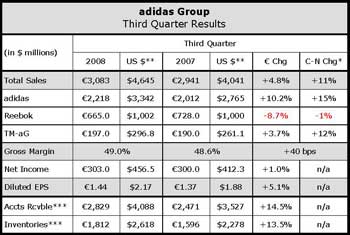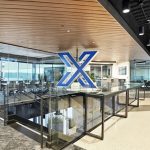adidas Group continued to struggle with its ailing Reebok business in the third quarter as the company continues to clear out entry price-point product from its inventories. That process is expected to be largely completed during the fourth quarter, which would set up the Reebok brand with the possibility of profitable operations in 2009.
Though adidas for the most part reports only year-to-date results, not often detailing quarterly numbers, the third quarter results can be easily gleaned from a comparison between the nine-month YTD and first half reported figures. The results presented here focus largely on implied third quarter numbers and not figures actually reported by adidas. All numbers in the accompanying charts, however, were supplied by adidas Group.
At Brand adidas, total sales in euro terms increased 10.2% to 2.22 billion ($3.34 bn) in the third quarter from 2.01 billion ($2.77 bn) in Q3 2007, but improved 15% when excluding the FX rate impact from the stronger euro against other currencies.
Owned-retail continued to outpace overall brand sales growth, increasing 15.0% in euro terms to 398 million ($600 mm) in Q3 from 346 million ($476 mm) in the year-ago period. For the third quarter, owned-retail accounted for 18% of brand sales, compared to 17% of sales last year. For the first nine months of the year, comparable store sales increased in the high-single-digits. However, comps had increased in the double-digits for the first half over the same period in 2007, suggesting that third quarter comps were somewhat soft.
Brand adidas revenues would have still increased 9.3% without the benefit of the owned-retail growth.
The Sport Performance category continued the double-digit growth rate established in the first quarter. For the first nine months of the year, all major product categories saw sales increase, with football (soccer) posting the largest growth. Sales in running, training and basketball grew at a double-digit rate for the nine-month period as well. Sport Performance sales for the first nine months of 2008 grew 19% on a currency-neutral basis.
For the third quarter, Brand adidas Sport Performance sales increased 10.7% to 1.76 billion ($2.64 bn), compared to 1.59 billion ($2.18 bn) in the year-ago period. adidas Sport Style revenues also posted healthy growth for the third quarter, up 9.4% to 453 million ($683 mm) compared to 414 million ($569 mm) in Q3 last year. Fashion sales increased in the double-digits for the first nine months of the year, while Originals grew “modestly.”
On a regional basis, Brand adidas sales, when measured in euros, increased in the double-digits in all regions except North America, where they were down mid-singles. Sales were up 10.3% in Europe to 1.18 billion ($1.78 bn) from 1.07 billion ($1.47 bn) in the year-ago period. Management raised sales expectations for full year brand sales growth in Europe to the high-single-digits, up from previous guidance of mid- to high-single-digit growth.
In North America, Brand adidas sales declined 5.9% in euro terms to 319 million ($481 mm) from 339 million ($466 mm) in Q3 last year. Currency fluctuations hurt the brands North America result as sales grew 3.2% for the quarter when measured in U.S. dollars. For the full year, Brand adidas revenues are expected to decline in North America as a “result of the tough market conditions and competitive retail environment.”
Asia/Pacific sales were up 16.8% for Q3 in euro terms to 508 million ($765 mm) from 435 million ($598 mm). On a conference call with analysts, management noted that the flagship store opened in Beijing prior to the Olympic Games is now averaging over 200,000 visitors a month. Year-to-date adidas sales in China have increased more than 50%. After slowing to low-teens growth in Q2, Brand adidas sales to Latin America rebounded to growth of 28.4% for the third quarter. Regional sales totaled 190 million ($286 mm) for the quarter, up from 148 million ($203 mm) last year.

Brand adidas gross margin improved 50 basis points to 49.8% of sales from 49.3% for the year-ago quarter. Management pointed to an “improving regional and product mix, further own-retail expansion and favorable currency movements” as driving the margin improvements. Operating profits for brand adidas also improved for the third quarter, growing 11.1% to 439 million ($661 mm) from 395 million ($543 mm) last year.
Management maintained overall brand sales growth expectations for the full year, projecting sales to grow in the low-double-digits on a currency-neutral basis. Growth is expected to be driven by both the Sport Performance and Sport Style divisions, as well as by owned-retail expansion and backlog increases. Despite a tough comparison with last year's futures orders that were up 16%, adidas' backlogs grew 4% at the end of September. With the exception of Europe, where backlogs were flat, orders increased in all regions.
Reebok segment revenues decreased 8.7% when measured in euros, but did manage to grow 0.2% in U.S. dollars. Sales declined 1% on a currency-neutral basis for the third quarter. Sales in North America declined 15.4% to $449 million (298 mm) when measured in U.S. dollars. Sales in North America declined 22.8% when measured in euros. Europe sales declined 8.6% in euro terms to 223 million ($336 mm) from 244 million ($335 mm) last year. Latin America sales jumped 208% in euro terms to 74 million ($112 mm) from 24 million ($33 mm) last year. Asia revenues decreased 4.2% in euros to 69 million ($104 mm) from 72 million ($99 mm).
Reebok owned-retail revenues partly offset the sharper declines in the wholesale business, with retail posting a 10.8% increase for the quarter in euro terms. In U.S. dollar terms, owned-retail grew 21.5% to $170 million (113 mm), representing 17% of Reebok segment sales in the third quarter compared to 14% in the year-ago period. Excluding owned-retail, Reebok segment sales decreased 3.2% in U.S. dollar terms to $830 million (551 mm). Reebok sales excluding owned-retail declined 11.7% in euro terms.
Reebok brand sales were 665 million ($1.00 bn) for the quarter, representing an 8.7% decrease in euro terms. Reebok brand sales decreased 1% in Q3 on a currency-neutral basis, despite “continuous progress in emerging markets.”
Rockport brand revenues decreased 11.2% in U.S. dollar terms to $102 million (68 mm) for the quarter versus $115 million (84 mm) in the year-ago period. For the year-to-date period, Rockport currency-neutral sales declined 10%.
Reebok-CCM Hockey was just above flat for the third quarter, growing 0.2% in U.S. dollar terms to $96 million (64 mm) in the third quarter from $96 million (70 mm) in Q3 last year. However, sales were down 8.6% when measured in euros. Currency-neutral sales decreased 2% for the year-to-date period.
Reebok segment gross margins declined 380 basis points for Q3 to 36.4%.
Management tempered its outlook for the Reebok brand this year, now expecting net sales to be “stable compared to last year.” The new outlook compares to earlier guidance of a mid- to high-singles sales increase for the year.













